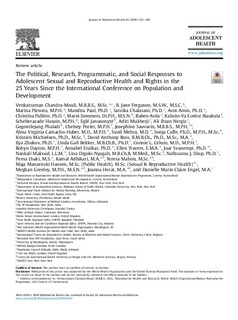| dc.contributor.author | Chandra-Mouli, Venkatraman | |
| dc.date.accessioned | 2019-12-17T15:00:08Z | |
| dc.date.issued | 2019-12-01 | |
| dc.identifier | oai:www.cmi.no:7061 | |
| dc.identifier.citation | in Journal of Adolescent Health vol. 65 no. 6 | |
| dc.identifier.issn | 1054-139X | |
| dc.identifier.uri | http://hdl.handle.net/11250/2633750 | |
| dc.description.abstract | Among the ground-breaking achievements of the International Conference on Population and Development (ICPD) was its call to place adolescent sexual and reproductive health (ASRH) on global health and development agendas. This article reviews progress made in low- and middle-income countries in the 25 years since the ICPD in six areas central to ASRH—adolescent pregnancy, HIV, child marriage, violence against women and girls, female genital mutilation, and menstrual hygiene and health. It also examines the ICPD's contribution to the progress made. The article presents epidemiologic levels and trends; political, research, programmatic and social responses; and factors that helped or hindered progress. To do so, it draws on research evidence and programmatic experience and the expertise and experiences of a wide number of individuals, including youth leaders, in numerous countries and organizations. Overall, looking across the six health topics over a 25-year trajectory, there has been great progress at the global and regional levels in putting adolescent health, and especially adolescent sexual and reproductive health and rights, higher on the agenda, raising investment in this area, building the epidemiologic and evidence-base, and setting norms to guide investment and action. At the national level, too, there has been progress in formulating laws and policies, developing strategies and programs and executing them, and engaging communities and societies in moving the agenda forward. Still, progress has been uneven across issues and geography. Furthermore, it has raced ahead sometimes and has stalled at others. The ICPD's Plan of Action contributed to the progress made in ASRH not just because of its bold call in 1994 but also because it provided a springboard for advocacy, investment, action, and research that remains important to this day. | |
| dc.language.iso | eng | |
| dc.relation | Journal of Adolescent Health | |
| dc.relation | 6 | |
| dc.relation.ispartof | Journal of Adolescent Health | |
| dc.relation.ispartofseries | Journal of Adolescent Health vol. 65 no. 6 | |
| dc.relation.ispartofseries | Journal of Adolescent Health vol. 65 no. 6 | |
| dc.relation.ispartofseries | Journal of Adolescent Health vol. 65 no. 6 | |
| dc.relation.ispartofseries | Journal of Adolescent Health vol. 65 no. 6 | |
| dc.relation.ispartofseries | Journal of Adolescent Health vol. 65 no. 6 | |
| dc.relation.uri | https://www.cmi.no/publications/7061-the-political-research-programmatic | |
| dc.subject | Adolescent Sexual and Reproductive Health | |
| dc.subject | International Conference On Population and Development (ICPD) | |
| dc.subject | Adolescent Pregnancy | |
| dc.subject | HIV | |
| dc.subject | Child Marriage | |
| dc.subject | Low- and Middle-Income Countries | |
| dc.title | The Political, Research, Programmatic, and Social Responses to Adolescent Sexual and Reproductive Health and Rights in the 25 Years Since the International Conference on Population and Development | |
| dc.type | Journal article | |
| dc.type | Peer reviewed | |
| dc.identifier.doi | https://doi.org/10.1016/j.jadohealth.2019.09.011 | |
| dc.identifier.doi | 10.1016/j.jadohealth.2019.09.011 | |
| dc.identifier.doi | 10.1016/j.jadohealth.2019.09.011 | |
| dc.identifier.doi | 10.1016/j.jadohealth.2019.09.011 | |
| dc.identifier.doi | 10.1016/j.jadohealth.2019.09.011 | |
